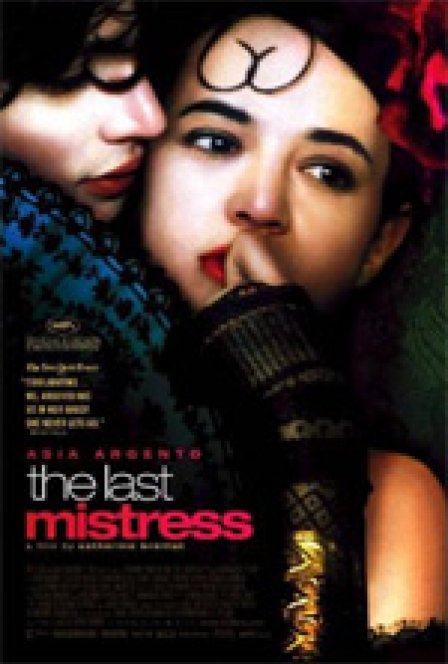“Wanton.” That’s the word that popped into my head upon first seeing Asia Argento onscreen in The Last Mistress, the wonderful new film by notorious French director Catherine Breillat. Languorously, almost lasciviously, reclining upon a chaise lounge in her sumptuously appointed 19th-century Parisian apartment, the first shots of Argento quickly and economically establish her character’s main attributes -- with her dark eyes and deep, sultry voice, she positively exudes a cloud of dangerous sexuality, power, and, beneath it all, a troubling hint of madness. With a look both inviting and terrifying, she appears more force of nature than woman. You can well imagine men destroying their lives in pursuit of her... as you can well imagine her reveling in such destruction.
Argento, an actress I’ve always been intrigued by but never before impressed with, delivers her finest performance to date as La Vellini, a Spanish woman living in Paris in 1835. She is the object of desire by many, but none more so than Ryno de Marigny, played here with an androgynous charm by newcomer Fu’ad Aïd Aattou, all pale skin and pouty lips. Marigny is set to be married to the beautiful but staid Hermangarde de Flers (Roxanne Mesquida, Fat girl) yet can’t help but creep away for one last rendezvous with Vellini, his mistress of ten years. While leaving her apartment, he is spied by the Vicomte de Prony (Michael Lonsdale) who, along with the Comtesse d’Artelles (Yolande Moreau), are set on disrupting the marriage. Being rich and old and thinking they know best, the two make it their business to save the Marquise de Flers (Claude Sarraute, in a fine performance) the “indignity” of having her granddaughter marry a no-account gambler and notorious womanizer with nary a title to his name. They shouldn’t have bothered, however, since the Marquise is a strong, independent aristocrat of an older generation, more than capable of making up her own mind. In an attempt to do so, she invites Marigny to her parlor where she has him recount for her the sordid tale of his tempestuous romance with Vellini, told in a long flashback sequence that occupies the middle two-thirds of the film’s length.
And what a tale it is, full of passionate fury and erotic despair, a rough and tumble imbroglio of a love affair in which hearts are broken, blood is drawn, and no one is left unscathed. All of this handled with consummate skill by Breillat, who brings newfound subtlety and dexterity to the screen only hinted at by her previous, taboo-busting films. Breillat’s recent stroke seems to have tempered her desire to provoke somewhat, although the film is in no way sentimental about affairs of the heart. Far from it. As one character remarks to another early in the film, “In love, the first to suffer has lost.” By the end of The Last Mistress, it is all too clear that everyone has lost.
Marigny and Vellini are trapped in a world of repressive social mores and meddling do-gooders, where libertines of their stripe are doomed to unhappy fates. All of this is contrasted with the character of the Marquis de Flers, the only person who seems to understand (though underestimate) the nature of the young lovers’ amour fou. Explicitly positioning herself as a creature of the 18th, rather than the 19th century, the Marquise is an exemplar of that Sadean archetype which flourished during the waning years of pre-revolutionary France. It seems to be a thesis of the film (as well as, presumably, the novel by Jules Barbey d’Aurevilly, of which this is a loose adaptation) that, with the crumbling of the monarchy and the rise of le petite bourgeoisie, there was lost a certain amount of sexual freedom, a freedom that could best be expressed by those who spent their days ensconced in palace intrigue rather than in the more energy-intensive struggles of a suddenly upwardly-mobile middle class.
Mention should be made at this point of the richly textured camera work by director of photography Yorgos Arvanitis, as well as the fine work by production designer Francoise-Renaud Labarthe and costume designer Anäis Romand, who clothes Argento in a dazzling array of outfits, both striking in design and fittingly appropriate in their evocation of character. Bravo.
While not a perfect film (it could have done with a bit of judicious editing in the third act), The Last Mistress is one that deftly encapsulates all of Breillat’s concerns as an artist without diluting them in her attempts to reach a wider audience. It is filled with fine performances and skillful direction. And yet at the last, I am left with the image with which I started this review: Asia Argento, eyes half-lidded, projecting a sense of calm, self-confident sexuality, barely concealing the maddening abyss within.

